- Research interest
- Our lab dedicated to conceptual change and digital learning researches for decades. We published series of pioneering studies including digital-based science reasoning, digital-based scientific argumentation, multimedia science learning and game-based science learning. Recently, we investigated construction and reconstruction of science concepts from cognitive perspective and used eye movements and electroencephalography (EEG) to uncover the relationship between the cognitive multimedia theory and students’ scientific knowledge construction. We also tried to explore how students construct scientific knowledge using EEG, why students can achieve successful conceptual change using eye movements and why Dual Situated Learning Model (DSLM) can facilitate student’s conceptual change using eye movements and EEG. So far, using eye movements, we have exposed the relationship between the cognitive multimedia theory and construction and reconstruction of science concepts such as genetics, meiosis, mitosis, chemical reaction, heat transfer and electricity.
- Research contents
- Research on scientific conceptual change
(1) Dual Situated Learning Model (DSLM) for scientific conceptual change
(2) Conceptual change and reasoning
(3) Digital-based scientific conceptual change
(4) Science reasoning and conceptual change - Research on digital-based scientific argumentation
(1) Scientific argumentation levels for different scientific contents.
(2) Argumentation and conceptual change. - Research on digital science learning
(1) Exploring the effects of digital learning environment on students’ science learning.
(2) Promoting science learning by constructing digital science learning content based on different theoretical frameworks. - Research on cognitive multimedia and science learning
(1) Exploring the relationship between modalities and different multimedia presentations.
(2) Exploring the relationship between different multimedia presentations and students’ scientific concept construction. - The relationship among cognition, scientific knowledge structure and conceptual change.
(1) Exploring the cognitive processes of the scientific knowledge construction using EEG and Eye Movements.
(2) Exploring why the Dual Situated Learning Model can promote student’s conceptual change using EEG and Eye Movements.
(3) Exploring the relationship between working memory capacity and students’ scientific knowledge construction and reconstruction. At the same time, exploring the relationship between working memory capacity and different multimedia presentations using Eye Movements.
(4) Exploring the cognitive processes of the knowledge construction through digital multimedia learning using Eye Movements and EEG. - Exploring the effects of game-based learning on students’ science learning and immersion experiences.
- Research on scientific conceptual change
- Experimental Equipments
- EyeLink 1000 system
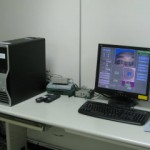
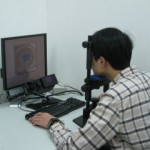
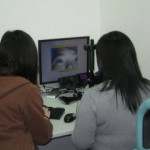
The EyeLink 1000 Desktop Mount system created by SR Research is used in this laboratory. The system contains a host computer, a display computer, a video overlay box, and a mobile eye-tracking device. The host computer is used to record eye movements and in setting up the hardware configuration. It can record a subject’s point of gaze with a lag time of only 2 milliseconds, allowing researchers to easily match a given point of gaze to a given experimental stimulus. The display computer is key to the design of an experiment and is used to present the experimental material, after which it uploads the relevant data to the host computer via the internet. The video overlay box is used to integrate dynamic images and gaze data so that we can observe a subject’s gaze as the subject looks at dynamic images. The EyeLink 1000 contains both monocular and binocular lenses for high-speed photography. The highest sampling rate is 1000 Hz, and the minimized average error of gaze is 0.15° (degree). The light weight and small volume of the system make it easy to carry, which in turn makes conducting experiments far more convenient. Both Experiment Builder and Data Viewer software are also used for experimental design and data analysis. The research we have conducted thus far with this eye-tracking system has mainly focused on using eye movements to explore students’ science learning in a digital learning environment. A key goal of our lab is to obtain a better understanding of students’ underlying cognitive processes during science learning, including their construction and reconstruction of scientific concepts in a digital learning environment. The following topics have been investigated thus far, with reports on some of them having been published in SSCI journals: eye movements during the construction of scientific concepts, how eye movements predict students’ computer-based assessments of physics concepts, the use of static and dynamic 3D animation representations to facilitate students’ construction of an atomic orbital mental model and its relationship with eye movement behaviors, scientific literacy and eye movements, and the use of an eye-tracking system to study the effectiveness of multiple representations of science concepts, among others.
Thus far, this laboratory has published a total of 7 eye movement research papers in various international journals:
- Liang, C. P., & *She, H. C. (2021). Investigate the effectiveness of single and multiple representational scaffolds on mathematics problem solving: Evidence from eye movements. Interactive Learning environments. doi.org/10.1080/10494820.2021.1943692. (SSCI) (IF=4.965)
- Chen, S. C., & *She, H. C. (2020). Effects of Analogical Learning Approaches and Presentation Modalities on Ninth Graders’ Learning Outcome and Eye Movements: a Preliminary Study. Journal of Science Education and Technology, 29, 547-560. https://doi.org/10.1007/s10956-020-09835-7. (SCI)(SSCI) (IF=2.315)
- Tsai, P.Y., Yang, T.T., *She, H. C., & Chen, S. C (2019). Leveraging College Students’ Scientific Evidence-Based Reasoning Performance with Eye-Tracking-Supported Metacognition. Journal of Science Education and Technology. 28(3),613-627(SCI)(SSCI) (IF=1.644) https://doi.org/10.1007/s10956-019-09791-x
- Tsai, P.Y., *She, H. C., Chen, S. C., Huang, L. Y., Chou, W.C., Duann, J.R., Jung, T.P. (2019). Eye Fixation-related Fronto-parietal Neural Network Correlates of Memory Retrieval. International Journal of Psychophysiology, 138, 57-70. (SCI) (SSCI) (IF=2.868) DOI: 10.1016/j.ijpsycho.2019.02.008
- Chen, S. C., Hsiao, M. S., *She H. C. (2015). The effects of static versus dynamic 3D representations on 10th grade students’ atomic orbital mental model construction: Evidence from eye movement behaviors. Computers in Human Behavior, 53, 169-180. (SSCI) (IF=2.880). https://doi.org/10.1016/j.chb.2015.07.003
- Chen, S. C., *She, H. C., Chuang M. H., Wu, J. Y., Tsai, J. L. & Jung, T.P. (2014). Eye movements predict students’ computer-based assessment performance of physics concepts in different presentation modalities. Computers & Education, 74, 61-72. (SSCI) (IF=2.556) https://doi.org/10.1016/j.compedu.2013.12.012
- *She, H. C. & Chen, Y.Z. (2009). The Impact of Multimedia Effect on Science Learning: Evidence from Eye Movements. Computers & Education, 53(4), 1297-1307. (SSCI) (IF=2.059) https://doi.org/10.1016/j.compedu.2009.06.012
- The Neuroscan SymAmps2
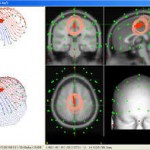
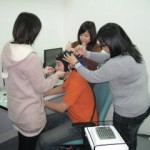
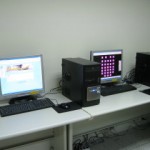
The NeuroScan SymAmps2 system is used to record EEG signals in this laboratory. The system’s hardware includes 64-channel electrode caps, signal amplifiers, a power supply, and 2 desktop PCs. The system also includes 64 unipolar electrodes and 4 bipolar electrodes that can record EEG, EOG, and ECG signals simultaneously. The sampling rate of each unipolar electrode can reach up to 20000Hz. The software for the system consists of 4 different programs, namely, the Scan4.4, STIM2, 3DSpaceDx, and Source programs. The main function of the Scan4.4 program is to record brainwaves and analyze data. With regard to data analysis, the Scan4.4 program can provide online analysis processing to allow for an immediate detection of a subject’s brain activity; moreover, it can also provide offline analysis processing after an experiment is completed. The STIM2 program is used for the adaptation of experimental materials and experimental procedures, and can connect to the Scan4.4 program via the internet in order to record stimuli data and a subject’s brainwave data simultaneously, which can facilitate subsequent offline data analysis. The 3DSpaceDx program is used to digitize precise electrode positions and head shapes, as well as to generate and render realistic surfaces. The Source program is used to detect the source location of brainwaves via operational data analysis, and to display 3D images that provide a better understanding of the given source area.
To analyze EEG data, our lab uses the EEGLAB toolbox for the MATLAB® platform. The data are analyzed using custom MATLAB scripts built on the open source EEGLAB toolbox (Delorme and Makeig, 2004)(http://sccn.ucsd.edu/eeglab). The EEGLAB toolbox can assess event-related spectral amplitudes from single electrodes and/or in ICA components. This lab uses EEG data to investigate the brain dynamics of all types of science education-related issues and topics. A key goal of our lab is to uncover the mechanisms of cognitive conflict and cognitive control in science learning, the construction of scientific concepts, and scientific conceptual changes in a digital learning environment. The following topics have been investigated in this lab: the encoding of scientific concepts, the retrieval of scientific concepts, scientific and mathematical problem solving, scientific reasoning, and scientific conceptual changes, among others. In addition, some of the results of these investigations have been published in SSCI or SCI journals.
We use the NeuroScan SymAmps2 system to collect the EEG signals produced during scientific concept construction and reconstruction. More specifically, we analyze spectral perturbations, the intensity of power spectra, topographies, and dipole sources to understand students’ brain dynamics during science learning. That is how we investigate the relations between brainwaves during scientific concept construction and reconstruction, as well as differing levels of learning efficiency.
So far, various studies involving brainwave research have been conducted in the fields of cognitive psychology, neural engineering, and physiology over many years, and the results have been informative. However, we still barely understand the cognitive mechanisms and functions of the brain. Cognitive functioning in the context of science learning could be relatively complicated in comparison to such functioning in other contexts, yet brainwave research has only rarely been applied in science education studies thus far. Therefore, our goal is to combine ERP and EEG technologies on the basis of science education theories in order to find new strategies for conducting science education research. Furthermore, we plan to combine EEG experiments with eye-tracking experiments so as to obtain direct biological and physiological evidence to inform our understanding of information processing and cognitive resource allocation during scientific concept construction and reconstruction. We hope that the results of such research will help us to obtain a better understanding of the complicated cognitive mechanisms involved in the science learning process in the future.
Thus far, this laboratory has published a total of 9 EEG research papers in various international journals:
- *She, H.C., Huang, L.Y, & Duann, J.R. (2023, 8). A Shared Hippocampal Network in Retrieving Science-related Semantic Memories. International Journal of Neural Systems. 33(8), 2350034. (SCI)
- Chou, W.C., She, H.C., & Jung, T. P. (2023, Feb.). Human brain dynamics and coordination reflect the task difficulty of optical image formation involves relational reasoning. International Journal of Neural Systems. 24 Feb 2023:2350018. DOI: 10.1142/s0129065723500181 (SCI) (IF:8.0)
- Liang, C. P., She, H. C., Huang, L. Y., Chou, W. C., Chen, S. C. & Jung, T. P. (2020). Human Brain Dynamics Reflect the Correctness and Presentation Modality of Physics Concept Memory Retrieval. Frontiers in Human Neuroscience. doi.org/10.3389/fnhum.2020.00331 (SCI)(IF=3.169)
- Huang, L. Y., *She, H. C. & Jung, T. P. (2018). Neural oscillation correlates chemistry decision-making. International Journal of Neural Systems. 28(3), 1750031. DOI: 10.1142/S0129065717500319 (SCI) (IF=4.580)
- Chen, S. C., Hsiao, M. S., *She H. C. (2015). The effects of static versus dynamic 3D representations on 10th grade students’ atomic orbital mental model construction: Evidence from eye movement behaviors. Computers in Human Behavior, 53, 169-180. (SSCI) (IF=2.880). https://doi.org/10.1016/j.chb.2015.07.003
- Chou, W.C., Duann, J.R., *She, H. C., Huang, L.Y., Jung, T.P. (2015). Explore the functional connectivity between brain regions during a chemistry working memory task. PLOS ONE, 10 (6), e0129019. (SCI) (IF=3.057). https://doi.org/10.1371/journal.pone.0129019
- Huang, L. Y., *She, H. C., Chou, W. C., Chuang, M. H., Duann, J. R. & Jung, T. P. (2013). Brain Oscillation and Connectivity during a Chemistry Visual Working Memory Task. International Journal of Psychophysiology. 90(2), 172-179. (SCI) (SSCI) (IF=2.648) https://doi.org/10.1016/j.ijpsycho.2013.07.001
- Lai, K., *She, H. C., Chen, S.C., Chou, W.C., Huang, L.Y., Jung, T.P., Gramann, K. (2012). Encoding of physics concepts: Concreteness and presentation modality reflected by human brain dynamics. PLoS ONE, 7(7): e41784. (SCI) (IF=3.730) https://doi.org/10.1371/journal.pone.0041784
- *She, H. C., Jung, T.P., Chou, W.C., Huang, L.Y., Wang, C.Y., Lin, G.Y. (2012). EEG dynamics reflect the distinct cognitive process of optic problem solving. PLoS ONE, 7(7): e40731. (SCI). (IF=3.730) https://doi.org/10.1371/journal.pone.0040731
- EyeLink 1000 system